Modèles opérationnels
Le rapport « La situation mondiale des transferts monétaires » du CALP Network identifie plusieurs types de modèles opérationnels, dont les consortiums et les alliances, les mécanismes de distribution des transferts partagés, un modèle de distribution des transferts monétaires articulé autour d’une seule organisation et l’intégration de systèmes.
« La structure générale au sein de laquelle les organisations travaillent conjointement […] pour distribuer les transferts monétaires […] lors d’interventions et d’activités d’analyse, et de la conception et de la mise en œuvre de programmes. »
Notre définition d’un modèle opérationel
Accroître l’échelle des transferts monétaires permet de transformer la manière dont l’aide humanitaire est distribuée. Cette décision a des conséquences sur les rôles des organisations dans le cadre de plusieurs modèles opérationnels, et sur la capacité des modèles à établir un lien avec les systèmes de protection sociale. Un changement d’échelle aura également un impact sur les partenariats avec des fournisseurs de technologies et de services financiers et sur la manière dont différents modèles interagissent avec d’autres formes d’assistance.
Priorités actuelles
Depuis fin 2016, le CALP Network assure la coordination d’un programme d’apprentissage visant à répondre aux questions suivantes :
- Quels sont les modèles opérationnels disponibles pour les organisations mettant en œuvre les transferts monétaires ?
- Comment différents modèles ont-ils amélioré l’efficience, l’efficacité et la transparence des transferts monétaires dans divers contextes ?
- Quels sont les modèles opérationnels les plus appropriés dans chaque contexte ?
Nous continuerons de compiler et diffuser notre base de données probantes sur les modèles opérationnels.
Nous sommes également partenaire du consortium Cash Monitoring, Evaluation, Accountability, and Learning Organizational Network (CAMEALEON), piloté par le Conseil norvégien pour les réfugié·es, qui est responsable du suivi et de l’évaluation indépendantes du programme d’assistance monétaire à usages multiples du PAM au Liban. À ce titre, nous menons des recherches et des analyses concernant l’optimisation des ressources et la redevabilité au sein du modèle opérationnel.
Contenu présenté

Operational Models: Accountability to affected people
Webinar

MEAL in Emerging Operational Models
Webinar

CTP Operational Models Analytical Framework
Guidelines and Tools
The State of the World’s Cash Report launched by the CALP Network in February 2018 highlights trends in the uptake of various operational models for the delivery of cash at scale in humanitarian response. Current decision making on the choice between these various operational models is highly influenced by context, and by the policies and approaches of donor agencies. Decision making on...
Thematic lead
Contenu récent
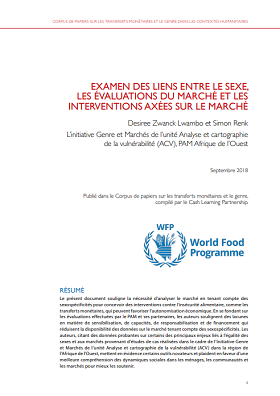
Examen des liens entre le sexe, les évaluations du marché et les interventions
Rapport
La relation entre le genre et l’assistance monétaire dans les contextes humanitaires
est mal comprise. Les interventions sont bien trop souvent définies à partir de suppositions plutôt que de faits réels.
Afin de comprendre comment l’assistance monétaire est bénéfique à tous, les acteurs de...

Review of Food for Peace Market-Based Emergency Food Assistance Programs: Sierra Leone Case Study Report
Report
Sierra Leone represents a remarkable experiment in market-based emergency programming using unconditional cash transfers and some conditional cash transfers Sierra Leone reflects the challenges of providing food assistance in the wake of a major infectious disease epidemic. Food insecurity increased due...

Le genre et les transferts monétaires : Répercussions de la prise de décisions au sein des ménages sur la nutrition des femmes et des enfants en Éthiopie
Case Study
La relation entre le genre et l’assistance monétaire dans les contextes humanitaires
est mal comprise. Les interventions sont bien trop souvent définies à partir de suppositions plutôt que de faits réels.
Afin de comprendre comment l’assistance monétaire est bénéfique à tous, les acteurs de...

Review of Food for Peace Market-Based Emergency Food Assistance Programs: Zimbabwe Case Study Report
Report
Zimbabwe reflects the recent Southern African drought crisis during a period of a regional El Niño-related drought and a national cash crisis. The United States Agency for International Development (USAID) Office of Food for Peace (FFP) funded a mix of programming between fiscal years 2011 and 2015,...

Examiner l’intégration de la prévention et de la lutte contre les violences basées sur le genre dans les interventions monétaires
Rapport
La relation entre le genre et l’assistance monétaire dans les contextes humanitaires
est mal comprise. Les interventions sont bien trop souvent définies à partir de suppositions plutôt que de faits réels.
Afin de comprendre comment l’assistance monétaire est bénéfique à tous, les acteurs de...

CTP Operational Models Analytical Framework
Guidelines and Tools
The State of the World’s Cash Report launched by the CALP Network in February 2018 highlights trends in the uptake of various operational models for the delivery of cash at scale in humanitarian response. Current decision making on the choice between these various operational models is highly influenced...
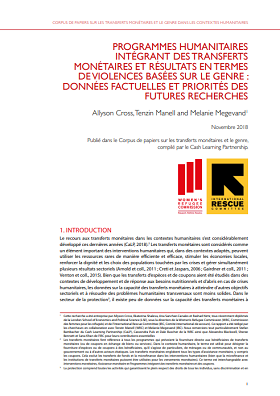
Programmes humanitaires intégrant des transferts monétaires et résultats en termes de violences basées sur le genre : données factuelles et priorités des futures recherches
Rapport
La relation entre le genre et l’assistance monétaire dans les contextes humanitaires
est mal comprise. Les interventions sont bien trop souvent définies à partir de suppositions plutôt que de faits réels.
Afin de comprendre comment l’assistance monétaire est bénéfique à tous, les acteurs de...

Cash-Based Programming in South Sudan
Report
This rapid review provides a synthesis of evaluations and learning reviews of cash-based programming in South Sudan. There is evidence that in South Sudan the cash-based programming help poor households address food needs and nutrition; and by injecting funds from vouchers, paid work, or grants into the...
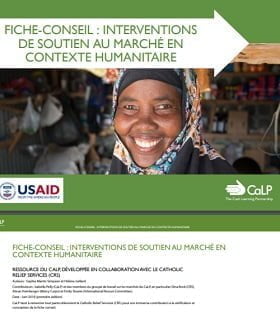
Fiche-Conseil : Interventions de soutien au marché en contexte humanitaire
Guides et outils
La fiche conseil définit le programme de soutien au marché en contexte humanitaire et le décrit dans la pratique. Elle permet aux praticiens humanitaires d’envisager systématiquement des interventions de soutien au marché, parallèlement à d’autres activités du programme. Le champ...

Reflecting on the 2017 Drought Response and Cash Coordination in Kenya
Report
This report brings together thoughts and reflections on the use of cash in the drought response in Kenya in 2017/18 and consider how cash coordination might be strengthened in future. These are from a half day learning event organised by the CALP Network in liaison with the Chair and Co-Chair of the Kenya...

Human(itarian) Capital? Lessons on Better Connecting Humanitarian Assistance and Social Protection
Report
Governments in low- and middle-income countries are increasingly investing in social protection, and also address many of their own people’s “humanitarian” needs themselves. For their international partners, who may have an important role in filling gaps when household needs exceed national capacity...

E-Voucher – Electronic Voucher – Cash Based Programming
Guidelines and Tools
Last Mile Mobile Solutions, LMMS E-Voucher Electronic Solution
The Electronic Voucher provides the ability to:
– Deliver cash programmes to beneficiaries through transfer of electronic vouchers
– Enables full end-to-end digitalized tracking of transactions
– Increases security of the transfers
–...
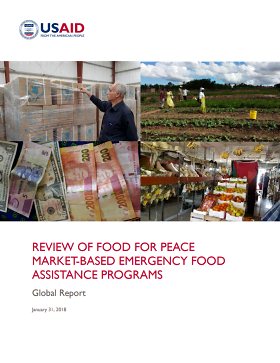
Review of Food for Peace Market-Based Emergency Food Assistance Programs Global Report
Report
Efficient and effective use of humanitarian funds is critical to meet the emergency needs of as many people as possible, especially as emergencies in developing countries have become more numerous, complex, and protracted. The United States Agency for International Development (USAID) Office of Food for...
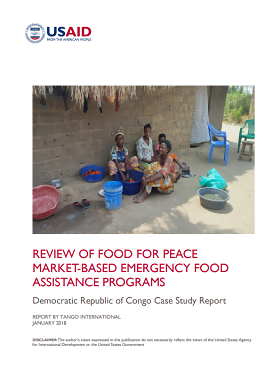
Review of Food for Peace Market-Based Emergency Food Assistance Programs: Democratic Republic of Congo Case Study Report
Report
The Democratic Republic of Congo (DRC) case illustrates the complexity and diversity of contexts within which program design and implementation occurs. It highlights the need for provincial-scale assessments, local market monitoring, and flexibility to pivot to different modalities depending on changing...
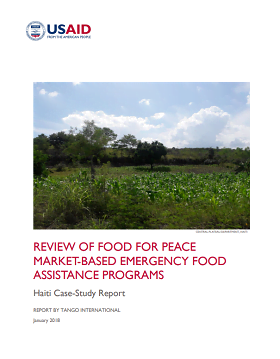
Review of Food for Peace Market-Based Emergency Food Assistance Programs: Haiti Case-Study Report
Report
Haiti is a very low-income country with a degraded ecological setting that faces repeated threats from multiple hazards. It is an excellent example of Food for Peace (FFP) linking emergency and development funding through the Kore Lavi Title II program that serves as a model for the national social...

Review of Food for Peace Market-Based Emergency Food Assistance Programs: Jordan/Turkey Case Study Report
Report
Syria regional crisis: The response to the Syria regional crisis exemplifies the challenges and opportunities involved with delivering food assistance in a widespread, largely urban refugee and internally displaced persons (IDP) crisis affecting middle-income countries. This case study focuses on...
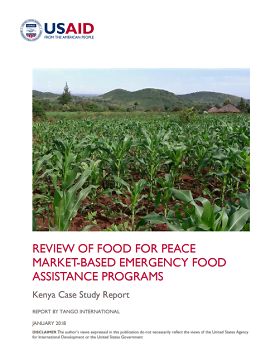
Review of Food for Peace Market-Based Emergency Food Assistance Programs: Kenya Case Study Report
Report
Kenya represents a country focused on building resilience through greater partnerships between USAID-Food for Peace (FFP) programs, other USAID-funded programs and local and national government. DESIGN: FFP MBEP in Kenya is a good example of connecting emergency and development programming and of...
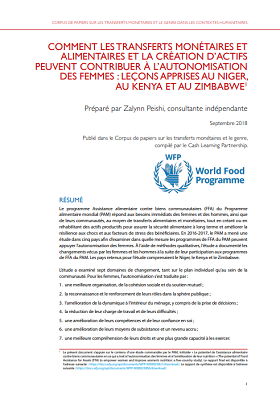
Comment les transferts monétaires et alimentaires et la création d’actifs peuvent contribuer à l’autonomisation des femmes : leçons apprises au Niger, au Kenya et au Zimbabwe
Rapport
La relation entre le genre et l’assistance monétaire dans les contextes humanitaires
est mal comprise. Les interventions sont bien trop souvent définies à partir de suppositions plutôt que de faits réels.
Afin de comprendre comment l’assistance monétaire est bénéfique à tous, les acteurs de...
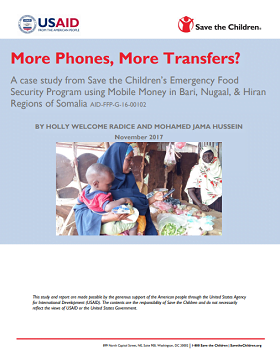
More Phones, More Transfers? A case study from Save the Children’s Emergency Food Security Program using Mobile Money in Bari, Nugaal, & Hiran Regions of Somalia
Report
In 2016-2017, with funding from USAID/FFP, Save the Children implemented a project targeting over 10,000HH the Bari, Nugaal, and Hiran regions of Somalia with monthly cash transfers using Mobile Money a partnership with Golis and Hormuud. The project sought to improve the food security situation in the...

Libya Cash and Markets Working Group (CMWG) Advocacy and Communications Plan
Report
The Libya Cash & Markets Working Group (CMWG) Strategic Framework & 2017 Workplan outlines ‘communication and advocacy’ as a ‘deliverable’ for supporting ‘HC/HCT decision making’.
Throughout March & April 2017, the CMWG Steering Committee used a series of tools as part of a seven-step process...



